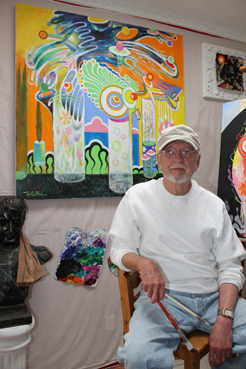

It has been said that, during the writing of a novel, a character in the book will suddenly change personality or take the story being written down an unexpected new path into a totally different plot that had never even occurred to the book's creator. Artists call this experience "the happy accident" and it's a joy when it works in the painter's favor.
This is a welcome phenomenon in my newer, more abstract paintings which are begun as totally non-objective pieces with no preconceived notion of what will come out of the slashing and splashing of color, mass and line. At a certain point in the opening round, I somehow instinctively know that it's time to leave the painting alone, cover it up or turn it to the wall and not look at it until the next day. That is the point at which one begins to really "see" what the painting is about and where it wants to go and what it is trying to say, not what the artist consciously wants to convey. Of course, decades of experience in drawing and painting can only help at this intuitive moment! Then begins the enhancing and development of all the strange shapes and colors that seem to mean something of importance. At a certain point, somewhere around the first half of the painting, the canvas might reveal in a flash where it is going and a title might even pop into mind.
And so the canvas and the painter dance along together, adding some things, removing others (with a few happy accidents along the way to spice things up a bit) until, finally, it has nothing more to say to the artist and it would be folly to try to force the process to continue. Adding a signature in the corner of the canvas is the painter's equivalent of the writer's last two words in a novel: "The End."
Photo by Ariana Dreschler

